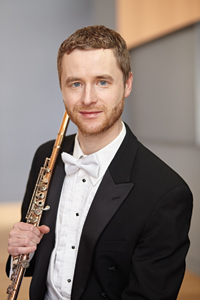 Greg Milliren, Minnesota Orchestra associate principal flute, is a graduate of the University of Minnesota (Julia Bogorad-Kogan) and the University of Southern California (Jim Walker). He has also studied with Adam Kuenzel, Immanuel Davis, Heather Clark, and Sarah Jackson. He has performed as a guest with Los Angeles Philharmonic, Seattle Symphony, Chicago Symphony, Boston Symphony, San Francisco Symphony, Detroit Symphony and Colorado Symphony.
Greg Milliren, Minnesota Orchestra associate principal flute, is a graduate of the University of Minnesota (Julia Bogorad-Kogan) and the University of Southern California (Jim Walker). He has also studied with Adam Kuenzel, Immanuel Davis, Heather Clark, and Sarah Jackson. He has performed as a guest with Los Angeles Philharmonic, Seattle Symphony, Chicago Symphony, Boston Symphony, San Francisco Symphony, Detroit Symphony and Colorado Symphony.
Where do you place your cork?
On my current piccolo I rarely adjust it from where it was placed by the maker or repair technician. In the past I have experimented with moving it in and out a bit. Moving it in helps get the high notes out better, but the sound is a little smaller. Moving it out results in a more resonant sound, but makes the high register more challenging. It is worth it to experiment a bit to see what cork placement gets you the best overall results. A small adjustment can make a big difference.
How do you align the headjoint with the body?
I line up the blowhole to be approximately in line with the C key on the body. When all is said and done, it is probably turned in very, very slightly from that, but the C key is a good approximation.
Do you wear one or two ear plugs?
At some point I always end up using two earplugs while practicing because I need to do long tones in the high register. In performance I like to just use one plug in the right ear so I can hear the section to my left better. I may add the left plug as well if the music is loud for an extended period of time. I always mark in my music when to put in or take out each earplug.
What alternate fingerings do you use on a regular basis?
First and second octave A: Add the G# key. Do this on flute as well to stabilize the pitch and add resonance to the note.
Third octave A: I sometimes add RH 3 and move my pinky from the D# key to cover the end of the piccolo. This helps bring the pitch down a little and stabilizes the note.
Third octave G: To slightly raise the pitch, I sometimes add the G# key + RH2,3.
Third octave G#6: Add right hand 2 and 3. This fingering, also useful on the flute, should be considered a standard fingering for piccolo.
Third octave B: To flatten the pitch, I sometimes use the first trill key instead of the second even though this is a more resistant fingering.
Third octave B: Use both trill keys and RH 3.
Third octave C: Add RH 2 to the regular fingering. I also sometimes finger high B without the thumb. This fingering is more resistant and can be flat, but it is in tune when played very loud.
Third octave C#: I often use LH 2,3, and RH 1 or LH 2,3, and RH 234.
Fourth octave C#: LH 2,3,4 and RH 1
While alternate fingerings are great, know your instrument and be in tune with yourself. You will still have to make some adjustments in rehearsals, but at least you know you will be in the ballpark.
How do you warm up?
I practice a long tone warmup in the low register to find a good sound. I try to be aware of where the piccolo is placed on the lip (higher than on the flute). I check my body alignment and think about relaxation. I know I tend to carry tension in my right shoulder and jaw, so it is important that I take care of that first thing. Then I move to the middle register via octaves off the low register or harmonics off the low register. It is also important to play long tones in the high register with a tuner. I practice loud and soft playing in each register with a tuner including crescendos and diminuendos. Also, I do a basic articulation warmup in each register that addresses both single and double tonguing.
For fingers I almost always play the Ab Major, A major and Bb major scales in the upper register and work on some of the more difficult cross fingering two-note combinations, such as E/F#, F#/G# (basically anything alternating with G#).
Do you have any tuning tricks when playing in an orchestra?
Listen, listen, listen. Always try to hear if you are playing in unison or octaves with someone else in the orchestra. Hear the next note you are about to play in your mind’s ear before you play it. For tricky wind chords, know which note you have in the chord. If you are having trouble, play quieter so you can hear what is going on around you better.
What are your thoughts on vibrato when playing the piccolo vs. the flute?
Piccolo vibrato is produced in the same way as on the flute, but the waves should be shallower since they will overly disturb the smaller airstream if produced as vigorously as on flute.
Do you single tongue or double tongue most things?
I tend to rely a lot on double tongue. Maybe more than I should. I do try articulated passages that are “on the edge” so to speak both ways to see what will work best for me.
What are the top excerpts a piccolo player should know well?
Sousa’s Stars and Stripes, Rossini’s Semeramide, Tchaikovsky’s Symphony No. 4, Ravel’s Bolero and Mother Goose Suite, Bartók’s Concerto for Orchestra, Prokofiev’s Lieutenant Kijé, Beethoven’s Symphony No. 9, and Shostakovich’s Symphonies No. 5 and 9.
Which piccolo players have influenced your playing?
Sarah Jackson, Los Angeles Philharmonic piccolo, taught me the most about how to play the piccolo in a way that worked for me personally. My colleague Roma Duncan is always an inspiration and makes a beautiful open sound I aspire to emulate. Jim Walker, who while not a piccolo player, per se, was a big influence with his encouragement and demonstration by example of how not to be intimidated by the instrument. He sounds terrific on piccolo, by the way!





